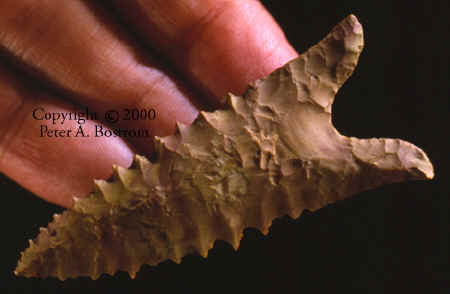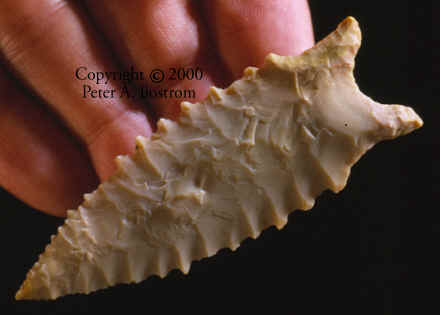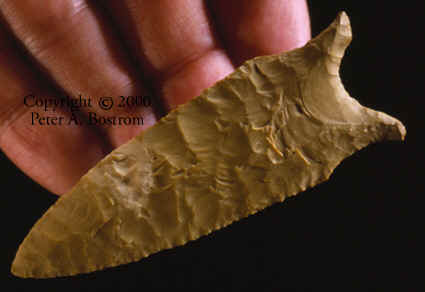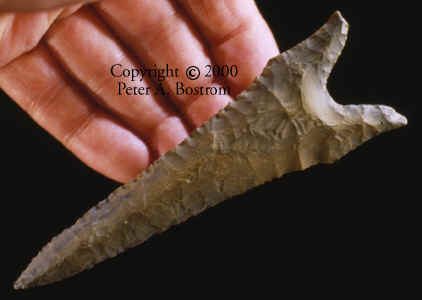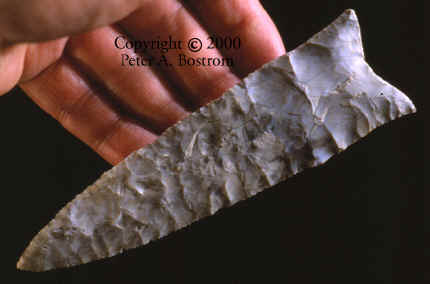|
SLOAN
SITE
NORTHEAST
ARKANSAS
ARKANSAS
ARCHEOLOGICAL SURVEY COLL.
The Sloan site was an Early Archaic Dalton culture site that was excavated
in the spring of 1974 by the Arkansas Archeological Survey. The site was
located on a low sand dune in northeastern Arkansas near the Cache River.
Although never proven absolutely, it's believed to have been a cemetery
and the artifacts found there were grave goods. This site, if the
interpretation is true, is the earliest organized cemetery in the New
World so far discovered to date.
A total of 448 Dalton culture projectile points and other
tools were excavated within an area of 36 by 39 feet. The artifacts were
found in clusters or caches that were laid out in generally six foot long
patterns. The individual caches and the way they were laid out is good
evidence that these were burials. It's believed that somewhere between 12
and 25 graves were originally located there. Only a very few tiny bone
fragments were found on the site.
Out of a total of 448 artifacts discovered 144 were Dalton
points. Many of them were made by very skilled craftsman. Several of these
points are some of the best examples of Dalton points that can be
found in any collection. The quality of manufacture and diversity of
styles are not unlike other cultural burial sites. The Mississippian site
at Cahokia Mounds in Illinois is famous for the excavation of Mound
72. Approximately 1200 very skillfully made arrow points were found
on that burial site. There have also been a few Clovis caches such as
Anzick in
Montana or the Simon cache in Idaho that are also similar with
finely crafted artifacts and associated with a burial (at least with
Anzick).
Just about every type of Dalton artifacts made of stone were
found on the Sloan site. Besides the 144 Dalton points there were Dalton
preforms and Adze preforms along with 30 complete adzes. Various types of
scrapers, abraders and cobble tools such as hammerstones were also found.
The 55 sandstone abraders found there is good evidence that these
people were probably working with such materials as bone or antler to make
such things as needles, hair pins, fishhooks or gorges, awls, etc.
The Sloan site is unique in many ways. One is that most
of the Dalton points are unbroken. This is almost unknown on other Early
Archaic sites. Many of the points are also not beveled or resharpened
which would indicate they may have never have been used.
The largest point found on the Sloan site is about 7 1/2
inches long and 2 3/8 inches wide. At least two of the largest Dalton
points found on this site was named Sloan Daltons by Dr. Dan F. Morse who
excavated the site. They are named after the owner of the land.
The Dalton period in the Central Mississippi Valley lasted
from approximately 10,500 to 9,500 years ago. In the southeastern United
States it's believed that the Archaic developed out of the Dalton period.
It's difficult to estimate the Dalton population during this
time. They probably lived in small family bands of 20 to 50 people. They
were organized hunters who hunted white-tailed deer, smaller animals,
fish, birds and gathered wild foods such as nuts berries and seeds.
Morse, Dan F., Morse, Phyllis A. 1983 pp 71-95 |
